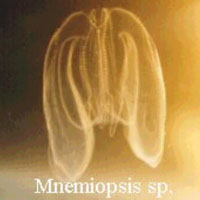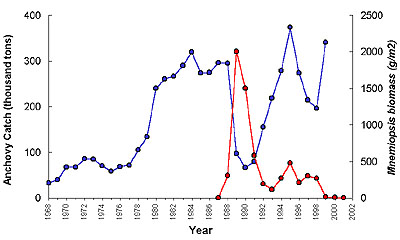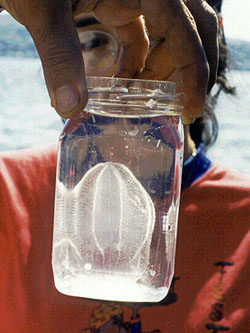The invasive ctenophore Mnemiopsis problem in the Black and
Caspian Seas
Ahmet E. Kideys
Institute of Marine Sciences,
Erdemli,
Turkey
kideys@ims.metu.edu.tr
 |
Figure 1. Mnemiopsis from the Black Sea.
In the 1980s, the introduction of a new species (a lobate ctenophore,
Mnemiopsis leidyi or M. mccradyi) (see Fig. 1) into the
Black Sea radically affected the whole ecosystem (Vinogradov et al.,
1989; Kideys, 1994).
This species had a negative impact on the most dominant fish of the
Black Sea, the anchovy Engraulis encrasicolus, through competion
for the edible zooplankton as well as consumption of anchovy eggs and
larvae. The mass occurence of Mnemiopsis was one
of the most important reasons for the sharp decrease of anchovy and
other pelagic fish stocks in the Black Sea (Kideys, 1994; Kideys et
al., 2000; see Fig. 2). Due to scale of the problem, UNEP has been
involved in order to find a solution for the impact of Mnemiopsis
on the Black Sea ecosystem (GESAMP, 1997).
Meantime, the possibility of its introduction into other neighbouring
sensitive ecosystems, notably the Caspian Sea, has been mentioned
(Dumont, 1995; GESAMP, 1997). However, another ctenophore, Beroe (either
ovata or cucumis, which is a subject of debate), wich
arrived in the Black Sea
in late 1990s, seemed very effective predator on Mnemiopsis
(see Fig. 3).
Several laboratory and field data suggest that Beroe feeds exclusively
on Mnemiopsis in the Black Sea (Finenko et al., 2001).
 |
Figure 2. The relationship between Mnemiopsis
biomass (red) and anchovy catch (blue) in the Black Sea (updated
from Kideys et al., 2000).
Arrival in the Caspian Sea
As expected, the Mnemiopsis ctenophore was reported from the Caspian Sea by
November 1999 (Ivanov et al., 2000). However, Iranian fishermen noticed
Mnemiopsis first time in 1998 summer (pers. comm. with Hasan
Fazli, Mazandaran Fisheries Research Center, Sari, Iran). To catch three
species of kilka, Iranian fishermen sish at night using a funnel net and
a light. Mnemiopsis would be very easily recognised using this method, so
we can safely assume that the occurrence of this ctenophore in
noticeable numbers dates from 1998 for the Iranian waters of Caspian Sea.
Ivanov et al. (2000) suggested that this ctenophore was transported
with ballast water taken aboard in the Black Sea or the Sea of Azov
(where Mnemiopsis occurs in warm months) and released after
ballast-loaded ships passed through the Volga Don Canal and the shallow,
freshwater North Caspian Sea, into the saltier Central or South Caspian
(Ivanov et al., 2000).
The impact of Mnemiopsis on the ecosystem of the Caspian Sea is
already very significant. Preliminary results from monitoring
programs set up in Azerbaijan and Iran clearly show that zooplankton
seems to be the worst-affected component of the ecosystem in the Caspian Sea
(Kideys et al., 2001a,b). The impact on lower trophic levels has been,
so far, appropriately reflected by the higher trophic levels. Pelagic
landing figures pointed to about a 50 % reduction for the Iran and
Azerbaijan fishery (Kideys et al., 2001a,b). Similar values were
presented by Russia with respect to fishery. There have also been lower
pregnancy figures, higher mortalities and consequently decreases in endemic
Caspian Seal populations recently (Shiganova et al., 2001).
 |
Figure 3. Black Sea Beroe.
Seeking a solution
The Caspian Environment Programme (CEP) located in Baku, Azerbaijan,
has organised very fruitful activities aimed at defining, stating and
proposing a solution to the Mnemiopsis problem in the Caspian Sea, with the help of
riparian countries and Mnemiopsis experts from different countries.
Among the activities were two meetings organised in Baku specially to
discuss Mnemiopsis. These meetings resulted in the setting up of ecosystem monitoring
programmes, with particular reference to Mnemiopsis, on Azeri coasts (supported by European TACIS
Programme) and in two
different regions of the Iran coast in the Caspian Sea (with the support of
the Iranian Fisheries Organisation, Shilat). In addition to these, a few
basin-wide surveys were taken by the riparian countries to assess the
ctenophore distribution in the entire Caspian (Shiganova et al., 2001;
Kideys and Moghim, 2002).
Experiments
One of the most important activities, howevwe, has been laboratory experiments with Beroe
that were transported to an
Iranian laboratory (Sari) on the Caspian (Kideys et al., 2001c); special
thanks to CEP and Shilat for supporting this important activity. In
these experiments, the adaptation and survival of Beroe, and its
miscellaneous physiological characteristics (feeding, spawning,
respiration), were measured in Caspian water conditions. Thus,
for example, we now know the diet and feeding rate of Beroe on Caspian
Mnemiopsis. During these experiments, different physiological aspects of
Caspian Mnemiopsis were also successfully studied (Kideys et
al.,
2001c).
The research goes on
We, as a group of scientists, are at present continuing our
experiments to assess the impact of Mnemiopsis and its control using
Beroe.
Bibliography
Dumont HJ 1995. Ecocide in the Caspian. Nature
377. 673-674.
GESAMP (IMO/FAO/UNESCO-IOC/WMO/WHO/IAEA/UN/UNEP
Joint Group of Experts on the Scientific Aspects of Marine Environmental
Protection) 1997. Opportunistic settlers and the problem of the
ctenophore Mnemiopsis leidyi invasion in the Black sea. Rep.
Stud. GESAMP, 58: 84p.
Finenko G. A., B.E. Anninsky, Z. A. Romanova, G. I.
Abolmasova & A. E. Kideys (2001). Chemical composition, respiration
and feeding rates of the new alien ctenophore, Beroe ovata, in
the Black Sea. Hydrobiologia 451:177-186.
Ivanov PI, AM Kamakim, VB Ushivtzev, T. Shiganova,
O. Zhukova, N. Aladin, SI Wilson, GR Harbison, HJ Dumont 2000. Invasion
of Caspian Sea by the comb jellyfish Mnemiopsis leidyi
(Ctenophora). Biological Invasions 2: 255-258.
Kideys A. E. 1994. Recent dramatic changes in the
Black Sea ecosystem: The reason for the sharp decrease in Turkish
anchovy fisheries. Journal of Marine Systems 5: 171-181.
Kideys A. E., A. V. Kovalev, G. Shulman, A. Gordina
& F. Bingel 2000. A review of zooplankton investigations of the
Black Sea over the last decade. J. of Marine Systems, 24:355-371.
Kideys A. E., Shahram Ghasemi, Davood Ghninejad,
Abulgaseem Roohi & Siamak Bagheri 2001a. Strategy for combatting Mnemiopsis
in the Caspian waters of Iran. A report prepared for the Caspian
Environment Programme, Baku, Azerbaijan, Final Report, July 2001.
Kideys A. E., F. M. Jafarov, Z. Kuliyev & T.
Zarbalieva 2001b. Monitoring Mnemiopsis in the Caspian waters of
Azerbaijan. A report prepared for the Caspian Environment Programme,
Baku, Azerbaijan, Final Report, August 2001.
Kideys A. E., G. Finenko, B. Anninski, T.
Shiganova, Abolgaseem Roohi, M. Roushan-Tabari, M. Youseffyan, M. T.
Rostamian, H. Rostami, H. Negarestan 2001c. Laboratory studies on
physiological characteristics of Beroe ovata and Mnemiopsis
leidyi in the Caspian Sea. Report prepared for the Caspian
Environment Program (CEP), Baku, Azerbaijan, December 2001.
Kideys A.E. & Mehdi Moghim 2002. Distribution
of the alien ctenophore Mnemiopsis leidyi in the Caspian Sea in
August 2001. Submitted to Marine Biology.
Shiganova T.A., Sokolsky A.F. Kaptyuk M.I. Kamakin
A. M. Tinenkova D. Kuraseva E.K 2001. .Investigation of invader
ctenophore Mnemiosis leidyi and its effect on the Caspian
ecosystem in Russia in 2001. A paper presented during the CEP Regional Mnemiopsis
Advisory Group First Workshop, Baku, Azerbaijan, 3-4 December 2001.
Vinogradov, ME, EA Shushkina, EI Musaeva & PYu
Sorokin (1989) Ctenophore Mnemiopsis leidyi (A. Agassiz)
(Ctenophora: Lobata) - a new settler in the Black Sea. Oceanology 29:
293-298 (in Russian).
|
